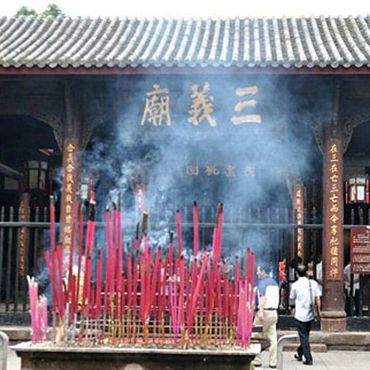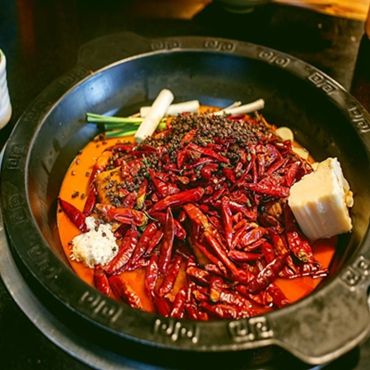Eating in Chengdu
Sichuan Food Briefing
Sichuan cuisine, one of the four and eight major traditional Chinese culinary traditions, stands as a cornerstone of Chinese gastronomy. Renowned for its extensive ingredient selection, diverse seasonings, and a wide array of dishes, it offers a palate that is both robust and refreshing. Celebrated for its adept use of spicy flavors, Sichuan cuisine is distinguished by its unique cooking techniques and rich regional character. It skillfully blends elements from various Chinese culinary traditions, continuously innovating and evolving. Chengdu, the capital of Sichuan Province, has been honored by UNESCO with the title of "City of Gastronomy," a testament to its culinary heritage.
Originating from the ancient states of Ba and Shu, Sichuan cuisine has evolved significantly over centuries. Its development began in the Spring and Autumn period, matured during the Han and Jin dynasties, and saw substantial growth in the Sui, Tang, and Five Dynasties eras. By the Song Dynasty, it had transcended regional boundaries, gaining national prominence. The late Ming and early Qing dynasties marked the incorporation of chili peppers, enhancing its flavor profile and establishing a tradition of bold, spicy tastes.
Post the late Qing Dynasty, Sichuan cuisine developed into a richly diverse local cuisine, encompassing banquet dishes, casual dining, home-style meals, steamed dishes, and flavored snacks, forming a comprehensive flavor system. Its distinct taste, characterized by clarity, richness, and intensity, particularly its use of Sichuan pepper and chili, has significantly influenced the culinary practices of the Yangtze River's middle and upper reaches, as well as Yunnan and Guizhou. In recent years, Sichuan cuisine has gained international acclaim, earning the reputation of "the taste of Sichuan" worldwide.
Originally confined to the Bashu region, Sichuan cuisine incorporates features from Chongqing, Chengdu, Leshan, Neijiang, and Zigong, showcasing a variety of flavors. Key seasonings include chili, Sichuan pepper, and broad bean paste, combined in various proportions to create flavors such as spicy, hot and sour, and fish-fragrant, each dish offering a unique taste experience. Historical records, such as those from the Huayang Kingdom, highlight the region's early agricultural and culinary practices, with evidence of sophisticated cooking techniques and condiment use dating back to the Warring States period.
The formation of Sichuan cuisine was significantly influenced by the political and economic developments during the Qin and Han dynasties. The migration of people from the Central Plains brought advanced agricultural techniques, enriching the region's culinary resources. The introduction of new ingredients during the Western Han Dynasty, such as cucumbers and walnuts, further diversified Sichuan cuisine's flavor palette. The stability during the Three Kingdoms period provided a conducive environment for the growth of commerce and the catering industry, solidifying Sichuan cuisine's foundational development.
This rich history and continuous innovation have made Sichuan cuisine a beloved and influential part of global culinary culture, celebrated for its depth of flavor and cultural significance.
Sichuan cuisine, one of the four and eight major traditional Chinese culinary traditions, stands as a cornerstone of Chinese gastronomy. Renowned for its extensive ingredient selection, diverse seasonings, and a wide array of dishes, it offers a palate that is both robust and refreshing. Celebrated for its adept use of spicy flavors, Sichuan cuisine is distinguished by its unique cooking techniques and rich regional character. It skillfully blends elements from various Chinese culinary traditions, continuously innovating and evolving. Chengdu, the capital of Sichuan Province, has been honored by UNESCO with the title of "City of Gastronomy," a testament to its culinary heritage.
The richness of Sichuan cuisine is further reflected in its regional diversity, which is traditionally divided into three main schools: Shanghe Gang, Xiaohe Gang, and Xiahe Gang. Shanghe Gang Sichuan cuisine, epitomized by the Rongpai style, is centered around the culinary practices of Chengdu and Leshan in western Sichuan. Xiaohe Gang Sichuan cuisine, characterized by the Yanbang style, focuses on the flavors of Zigong in southern Sichuan, extending to include the culinary traditions of Yibin, Luzhou, and Neijiang. Xiahe Gang Sichuan cuisine is represented by the bold and hearty Jianghu cuisine of Chongqing and the robust Big Bowl cuisine of Wanzhou. Together, these three branches form the core of Sichuan cuisine's local flavor schools, showcasing the pinnacle of its culinary artistry and development.
Famous Local Dishes
Famous Local Dishes
Kung Pao Chicken(Gongbao Ji Ding宫保鸡丁)
The rise to fame of Kung Pao Chicken is shrouded in numerous stories, blending official records with rich folklore, with versions of its origin traced to Guizhou, Shandong, and Sichuan. According to the annals of Zhijin County in Guizhou, Ding Baozhen, as a child, once fell into the water and was rescued by a family living near a bridge. Grateful, upon becoming an official, he revisited the family to express his gratitude. They prepared a special dish to honor him, which later, during his tenure as the governor of Shandong, he asked local chefs in Jinan to replicate using a method known as "sauce burst." This dish, initially named "sauce burst chicken," became a staple for entertaining guests at his residence. Its popularity soared locally, and following Ding's commendable service in quelling bandits, he was bestowed the title "Prince Shaobao," colloquially known as "Gong Bao." Consequently, the dish was renamed "Kung Pao Chicken" in his honor.
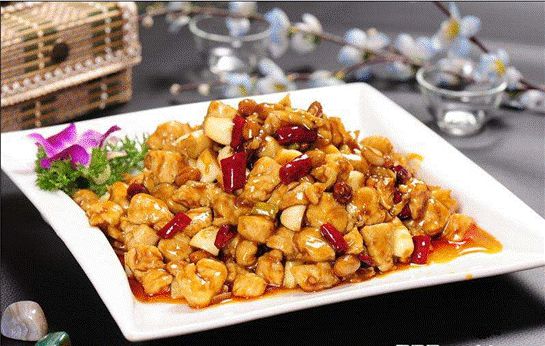
Upon his promotion to the governor of Sichuan, Ding brought his culinary team with him. They adapted the dish to suit the local palate, incorporating spicy elements that resonated well with both officials and the general populace. This adaptation facilitated its rapid spread across the region and eventually to the capital, where it was served as a tribute dish to the emperor, elevating it to a prestigious palace cuisine. The dish's popularity spurred a competitive spirit among Sichuanese chefs, each vying to perfect their version of Kung Pao Chicken to attract more clientele. Its acclaim spanned official, folk, and imperial circles, earning it the esteemed title of "national dish."
In 1986, Kung Pao Chicken made its international debut at the "Fifth Luxembourg Food Exhibition and World Cup Cooking Competition," where it captivated the audience and marked China's successful entry into the global culinary scene. Its popularity in the West led to local adaptations, resulting in a "Western Kung Pao Chicken" tailored to Western tastes. Today, Western tourists visiting Sichuan, Shandong, and Guizhou often seek the authentic experience of this iconic dish.
Kung Pao Chicken's journey mirrors that of a person: originating from the humble beginnings in Guizhou, it ventured beyond the mountains, steadily gaining recognition and acclaim. The dish demands meticulous selection of ingredients and sophisticated cooking techniques, making it a challenge for even seasoned chefs to master. The authentic preparation involves marinating high-quality chicken leg meat, stir-frying it to perfection, and blending it with a trio of peppers—Huaxi, Zunhe, and Da Fang—each contributing a unique flavor profile. This combination, along with ginger and garlic, creates a symphony of flavors that defines the true essence of Kung Pao Chicken.
Yuxiang Shredded Pork(Yuxiang Rou Si鱼香肉丝)
Yuxiang shredded pork, a quintessential Sichuan dish, is celebrated for its unique "fish fragrance" flavor profile, despite containing no fish. The dish begins with fresh pork, sliced into thin shreds, marinated with egg and starch, and then briefly fried in oil until tender. After draining the excess oil, the pork is stir-fried with a medley of ingredients including chili, wood ear fungus, onions, and bean paste, which infuse the dish with its signature aroma and depth of flavor. The result is a dish with silky-smooth meat, a harmonious blend of spicy and savory notes, and a universal appeal that makes it suitable for a wide range of palates.

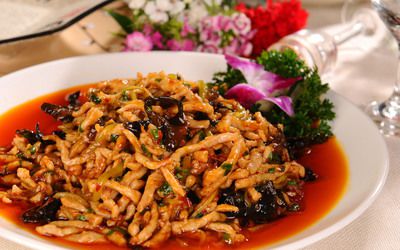
The term "fish fragrance" (yuxiang) refers to the seasoning style rather than the inclusion of fish. This distinctive flavor was developed by Sichuan chefs in the early 20th century, as evidenced by the absence of fish-flavored dishes in the 1909 publication Overview of Chengdu, which cataloged 1,328 Sichuan dishes. The "fish fragrance" is achieved through a combination of pickled peppers, Sichuan salt, soy sauce, sugar, minced ginger, minced garlic, and scallions. This seasoning mimics the spices and techniques traditionally used in Sichuan-style fish cooking, creating a complex flavor profile that is salty, sweet, sour, spicy, fresh, and aromatic. Despite its name, the dish does not taste like fish but rather embodies the essence of Sichuan culinary ingenuity.
The fish fragrance flavor is one of the hallmark seasoning styles in Sichuan cuisine. It derives its unique taste not from fish but from a carefully balanced blend of condiments such as red peppers, scallions, ginger, garlic, sugar, salt, and soy sauce. This method, inspired by the traditional Sichuan approach to cooking fish, has become a cornerstone of the region's culinary repertoire, characterized by its rich, layered flavors and the prominent use of aromatic ingredients like ginger, garlic, and scallions.
The key to perfecting this dish lies in the selection and preparation of the pork. Ideally, the pork should consist of 30% fat and 70% lean meat, sliced thinly and stir-fried to achieve a tender, succulent texture. When executed correctly, the dish boasts a vibrant red hue, tender meat, and a fresh, flavorful quality that exemplifies the rich, fish-like aroma for which it is named. Yuxiang shredded pork is a testament to the artistry of Sichuan cuisine, blending tradition, innovation, and bold flavors into a single, unforgettable dish.
Mouthwatering Chicken(Koushui Ji口水鸡)
The name Mouthwatering Chicken (Koushui Ji) might evoke a playful curiosity, but its origin is deeply rooted in literary history. The renowned Chinese writer Guo Moruo, in his work The Waves, reminisced about his childhood in Sichuan: "When I was a boy in my hometown of Sichuan, I ate white chopped chicken, white meat, red hot chili oil, and Sichuan pepper. Even now, the memory makes my mouth water." Inspired by this vivid description, people adopted the term "mouthwatering" to name this dish, eventually giving rise to the famous Koushui Ji.
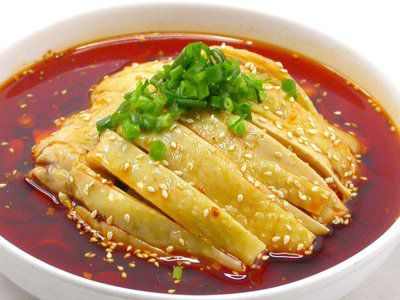
Mouthwatering Chicken is a quintessential Han Chinese dish from Sichuan, celebrated for its bold flavors and refreshing texture. As a cold dish in Sichuan cuisine, it combines a rich array of seasonings to create a harmonious blend of spiciness, umami, and tenderness. The preparation of this dish is meticulous, particularly in the cooking of the chicken broth, which requires precise timing and technique to preserve the chicken's natural flavors and texture.
The main ingredient is 500 grams of Sanhuang chicken, a high-quality free-range chicken known for its tender meat. The dish is enhanced with a variety of spices and condiments, including scallions, green peppers, millet chilies, crispy peanuts, light soy sauce, white sugar, ginger, garlic, and red chili oil. The key to its success lies in achieving the perfect balance of flavors and textures, ensuring that the chicken remains succulent and flavorful while absorbing the complex, spicy, and aromatic sauce.
The unique taste of Mouthwatering Chicken comes from its signature sauce, which typically includes Sichuan pepper, chili oil, garlic, and other seasonings. This combination creates a numbing, spicy, and slightly sweet flavor profile that is both addictive and unforgettable. The dish is often garnished with crushed peanuts and chopped scallions, adding a delightful crunch and freshness.
Mouthwatering Chicken is not just a dish but a testament to Sichuan cuisine's ability to transform simple ingredients into a culinary masterpiece. Its name, derived from a literary reference, perfectly captures the irresistible allure of this spicy, savory, and utterly mouthwatering delicacy. Whether enjoyed as a cold appetizer or a main course, it continues to captivate food lovers with its bold flavors and cultural significance.
Mapo Tofu(Mapo Dou Fu麻婆豆腐)
Mapo Tofu is a celebrated traditional dish from Sichuan Province, renowned for its bold and distinctive flavors, epitomizing the essence of Sichuan cuisine. The dish primarily features tofu, complemented by garlic sprouts and minced beef (or other meats as alternatives). The seasoning blend typically includes fermented bean paste, chili, Sichuan peppercorns, soy sauce, light soy sauce, dark soy sauce, sugar, and starch, which together create its signature complex and spicy taste profile.
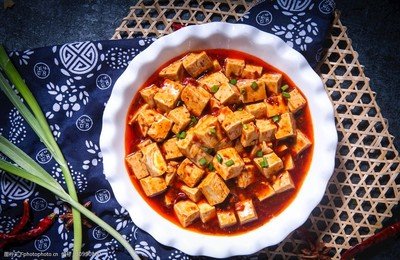
The unique combination of Sichuan peppercorns and chili gives the dish its characteristic numbing spiciness and intense flavor. The flavor profile of Mapo Tofu is a harmonious blend of numbing from the Sichuan pepper, spiciness from the chili, along with a balance of fresh, fragrant, hot, and savory elements. The dish is known for its vibrant colors, tender tofu, and a satisfying combination of textures—from the crispy garlic sprouts to the smooth tofu, creating a perfect representation of Sichuan’s spicy flavor profile.
At the end of the Qing Dynasty, near the Wanfu Bridge pier in Chengdu, a small restaurant run by a woman named Chen Mapo became the birthplace of one of Sichuan's most iconic dishes. Chen Mapo, whose nickname "Mapo" (meaning "pockmarked lady") came from the small scars on her face, was known for her culinary ingenuity. In 1862, during the first year of the Tongzhi reign, her restaurant was nearly out of ingredients at closing time when a group of dockworkers arrived, asking for a hearty yet affordable meal. With only tofu and minced beef left, Chen Mapo improvised by stir-frying the tofu with a blend of seasonings, including fermented bean paste, black beans, Sichuan peppercorns, and chili peppers. The result was a dish that was numbing, spicy, and deeply flavorful. The workers were so impressed by its bold taste that they spread the word, and soon, "Chen Mapo Tofu" became a local sensation.
Chen Mapo, originally named Wen Qiaoqiao, was the seventh daughter of the owner of Wanfeng Sauce Garden in Chengdu's North Gate. Despite her beauty, she was affectionately called "Mapo" due to the pockmarks on her face. At 17, she married Chen Zhihao, the fourth shopkeeper of a local timber business. Their marriage was happy, but tensions with her in-laws led to her eventual independence. After moving to Ma Jia Grind with her husband, the couple lived modestly, renting out rooms and working in a nearby oil mill. Chen Zhihao was known for his kindness, often helping porters who passed through the area. In gratitude, the porters would bring ingredients, which Qiaoqiao used to create dishes like her famous tofu and lamb stew.
Tragedy struck when Chen Zhihao died unexpectedly, leaving Qiaoqiao and her sister-in-law, Shu Hua, to fend for themselves. Determined to survive, they opened their home to travelers, offering homemade meals. Qiaoqiao's tofu dish, with its perfect balance of spice and flavor, quickly gained fame throughout western Sichuan. Despite societal pressures and family objections, she continued to run her business, eventually expanding her restaurant. Her adopted nephew later left to join the army, and after years of hard work, both Qiaoqiao and Shu Hua passed away, leaving behind a legacy that would endure for generations.
Today, Mapo Tofu is not just a dish but a symbol of resilience and creativity. The name "Mapo" honors Chen Mapo's strength and the beauty she embodied, despite societal judgments. Her story and her dish have become an integral part of Sichuan's culinary heritage, celebrated by locals and international visitors alike.
Double-boiled pork(Huiguo Rou回锅肉)
Double-boiled pork is a time-honored dish in Sichuan cuisine, celebrated for its rich flavors and tender texture. The traditional preparation method involves selecting pork leg with a balanced ratio of fat and lean meat. The meat is first boiled until about 80% cooked, then cooled and sliced. In a wok, a combination of vegetable oil and lard is heated, and the sliced pork is added. Over a slow flame, the fat is rendered out, releasing its rich oils. A pinch of salt and Pixian bean paste are then added, stir-fried until fragrant. Finally, a generous amount of green garlic sprouts is incorporated and stir-fried briefly to complete the dish. When served, the dish exudes a thick, savory aroma from the gravy and the fresh scent of garlic sprouts, filling the room with an irresistible fragrance. Each bite offers a delightful balance—rich and flavorful yet not greasy, with a melt-in-your-mouth tenderness that makes it an excellent accompaniment to wine or rice. Additionally, this dish can be enhanced by stir-frying it with seasonal vegetables such as garlic, chili peppers, and leeks, adding layers of flavor and texture to the already delectable dish.
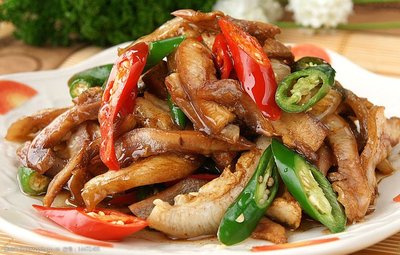
Famous Local Snacks
Bobo Chicken(Bobo Ji钵钵鸡)
Bobo Chicken, a renowned local snack from Leshan, Sichuan Province, is a cherished part of Sichuan cuisine with a history that spans several centuries. The name "Bobo" derives from a traditional pot adorned with a distinctive red and yellow porcelain dragon pattern. This pot is filled with a spicy seasoning blend, and the ingredients, meticulously prepared and skewered, are immersed in a variety of flavorful marinades. This unique preparation method not only enhances the dish's taste but also adds to its visual appeal. Recognized for its excellence, Bobo Chicken was awarded the Chengdu Snack Quality Award in 1990 and was honored as a "High-Quality Famous Snack" by the Chengdu People's Government in 1991.
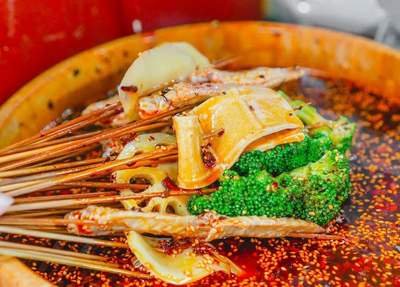
Originating from rural areas, Bobo Chicken's rustic charm distinguishes it from conventional dining experiences. It has redefined the traditional notion that skewered foods must be served hot, making it particularly popular among the fast-paced younger generation.
The dish's convenience and adaptability make it ideal for sale at stalls or through mobile vending, offering a business model that diverges from traditional catering. There is no need for a formal ordering process, and customers do not have to endure long waits or rely on extensive service staff. The variety of flavors and complementary products further enhance customer choice.
Bobo Chicken is not only easy to eat but also budget-friendly. Diners can customize their skewers according to personal preferences, choosing from a range of meats, vegetables, and spice levels. Each skewer is priced at around 50 cents, allowing customers to enjoy a few skewers or indulge in more than ten, all while keeping costs relatively low.
The simplicity of Bobo Chicken extends to its preparation. In addition to chicken, a variety of seasonal vegetables and meats can be used as ingredients. Raw materials are purchased based on actual sales demand, and most dishes are prepared in advance, minimizing inventory pressure and ensuring operational efficiency. This streamlined approach makes Bobo Chicken a practical and appealing option for both vendors and diners alike.
Brown Sugar Glutinous Rice Cake(Hong Tang Ciba红糖糍粑)
Brown sugar glutinous rice cake is a traditional and classic snack in Sichuan area, which is made of brown sugar, glutinous rice and soybean powder. Brown sugar is rich in nutrients, can quickly release heat, improve nutrient absorption rate, in addition to sucrose, but also contains a small amount of iron, calcium, carotene and other substances.

Recommended Restaurants
For your reference, the following are the restaurants rated most popular by the locals:
Chen Mapo Tofu(Chen Mapo Doufu陈麻婆豆腐)
Description:Chen Mapo Tofu is one of Chengdu's most iconic restaurants, famous for its authentic Mapo Tofu. The dish is known for its numbing spiciness, tender tofu, and fragrant minced beef, making it a classic of Sichuan cuisine.Address:No. 197, Xiyulong Street, Qingyang District, Chengdu.
Long Chaoshou龙抄手
Description: Long Chao Shou is a time-honored snack restaurant in Chengdu, renowned for its Chao Shou (dumplings). The dumplings feature thin wrappers and generous fillings, served in a flavorful broth with options like spicy chili oil or clear soup.Address: No. 63, Chengshou Street, Jinjiang District, Chengdu.
Zhong's Dumplings(Zhong Shuijiao钟水饺)
Description: Zhong's Dumplings is a traditional snack shop in Chengdu, famous for its red oil dumplings. The dumplings are known for their thin wrappers, tender fillings, and a sweet-spicy red oil sauce.Address: No. 2, Wuhouci Street, Wuhou District, Chengdu.
Shu Jiuxiang Hot Pot(Shu JiuXiang Huoguo蜀九香火锅)
Description: Shu Jiuxiang is a well-known hot pot chain in Chengdu, famous for its rich beef tallow broth and wide variety of ingredients. With an elegant atmosphere and attentive service, it's a great place to experience Chengdu's hot pot culture.Address: No. 11, Nijiaqiao Road, Wuhou District, Chengdu.
Fuqi Feipian夫妻肺片
Description: Fuqi Feipian is a time-honored cold dish restaurant in Chengdu, famous for its spicy beef offal slices. The thin and chewy slices are served with a special spicy sauce, offering a rich and flavorful experience.Address: No. 23, Zongfu Road, Jinjiang District, Chengdu.
Lai's Glutinous Rice Balls(Lai Tangyuan赖汤圆)
Description: Lai's Glutinous Rice Balls is a traditional dessert shop in Chengdu, famous for its handmade rice balls. The rice balls are known for their thin wrappers and generous fillings, with options like sesame and peanut.Address: No. 10, Section 1, Renmin Middle Road, Qingyang District, Chengdu.
Tan Fish Head(Tan Yutou谭鱼头)
Description: Tan Fish Head is a famous fish head hot pot restaurant in Chengdu, known for its fresh fish heads and unique broth. The tender fish meat and spicy broth make it a favorite among diners.Address: No. 20, Section 4, Renmin South Road, Wuhou District, Chengdu.
Laoma Tihua老妈蹄花
Description: Lao Ma Ti Hua is a specialty snack shop in Chengdu, famous for its braised pig trotters. The trotters are tender and flavorful, served in a rich broth with a secret dipping sauce.Address: No. 7, Dongchenggen South Street, Qingyang District, Chengdu.
Bashu Dazhaimen Hot Pot (Bashu Dazhaimen Huoguo巴蜀大宅门火锅 )
Description:Bashu Dazhaimen is a popular hot pot restaurant in Chengdu, known for its authentic Sichuan-style broth and wide variety of ingredients. The restaurant's traditional decor reflects Sichuan's cultural heritage.Address: No. 143, Kehua North Road, Wuhou District, Chengdu.
Kuanzhai Alley Snack Street(Kuanzhai Xiangzi宽窄巷子小吃街)
Description: Kuanzhai Alley is a famous historical and cultural district in Chengdu, home to a variety of traditional Chengdu snacks. Visitors can enjoy authentic local dishes like Zhong's Dumplings, Long Chao Shou, and Three Cannons here.Address: Kuanzhai Alley, Changshun Street, Qingyang District, Chengdu.


